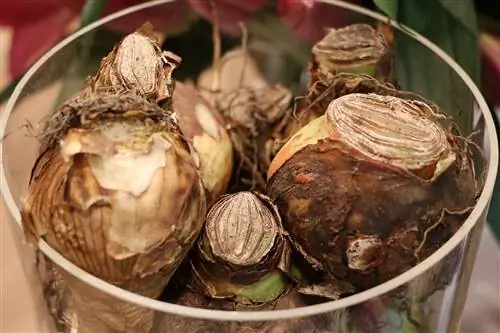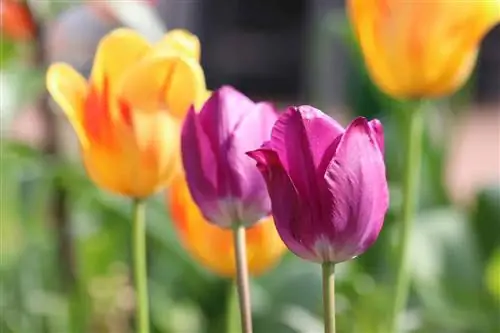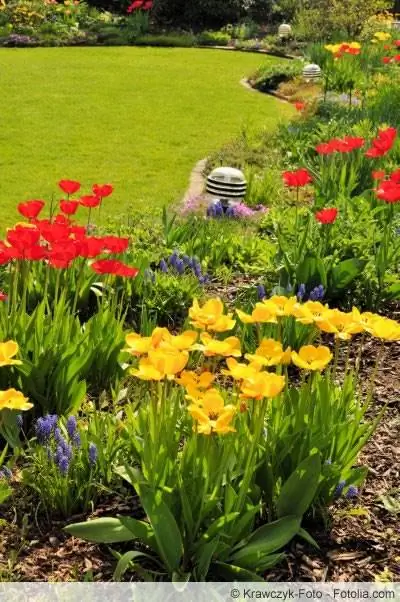- Author admin [email protected].
- Public 2023-12-17 03:39.
- Last modified 2025-01-24 12:45.
Perennial tubers in particular require intensive care in order to develop their annual blooms. The causes for the absence of flowers and appropriate treatment measures are listed below.
Inappropriate location
The tulips prefer a sunny to partially shaded location. This should be exposed to direct sunlight for at least six hours a day. A north orientation is therefore not possible. Choose a location facing south or south-west to ensure adequate exposure. In addition, the chosen location should provide protection from wind. Strong gusts can cause the stems to snap.
In addition, the existing substrate should have a loose and humus-rich consistency. The onions do not particularly tolerate heavily compacted soils. Therefore, loosen the soil in advance with sand, clay or gravel.
Unfavorable weather conditions
The bulb needs an appropriate ratio of heat and moisture to develop flowers. The tuber plants can only cope to a limited extent with particularly adverse weather conditions such as persistent frost or high rainfall. As a result, rather simple leaves are formed instead of the opulent flowers. To protect the sprouts, it is recommended to set up a roof. This can be made of either plastic or glass. In addition to keeping the annoying moisture away, the temperature is also kept much more stable.
Tip:
When using a gap-free hood, make sure that it is ventilated regularly. Otherwise there is a risk of mold due to the high moisture content!
Inadequate fertilization
The annual emergence of leaves and flowers requires Tulipa to always use nutrient and energy reserves. If these are at a level that is too low, only leaf growth will be forced. For a complete nutrient supply, the use of a complete, organic-based fertilizer is recommended.
Suitable fertilizers are:
- Mulch
- Compost
- Manure
- Crap
- Stinging nettle manure
- Horn shavings
- organic liquid fertilizer
After the old flowers and leaves have completely dried in autumn, the soil should be prepared for the next flowering period with a slow-release fertilizer. After the first shoots have formed, further fertilization should be carried out.
Pest or disease infestation
Mainly tulip bulbs that are already weakened are attacked by pests and pathogens. The main cause of a weak tuber is inadequate care or an unsuitable location. Various pathogens such as fungi and viruses have an easy time with these plants. As a result, they often cause complete death. However, even seemingly he althy plants can be affected by air or moisture. Any tulipa that are noticeably altered should therefore be disposed of as quickly as possible.
The most common pest encountered is the vole. This approaches via its underground tunnels and then eats large parts of the onion. Killing rodents is prohibited in this country, which is why they can only be sold away.
Adequate home remedies are:
- fermented buttermilk
- garlic
- Herbal oil
- Spruce or thuja manure
- Alcohol
Note:
Alternatively, wire mesh available from specialist retailers can also be placed around the plants. However, regular checks for holes must be carried out.
Incorrect planting
When planting new tubers, pay attention to both the right time and an appropriate planting depth. Ideally, planting takes place in the fall before the first frost. The maximum temperature should still be a maximum of 10 degrees Celsius. This allows the bulb to become sufficiently rooted in the ground before winter dormancy. If planted too late, it will either die or not develop its roots until the following spring.

In addition, planting at a depth that is too deep uses up important nutrient reserves. These are actually needed for the formation of the flowers. Therefore, make sure to dig an appropriate hole. As a rule of thumb, the hole should be a maximum of twice as deep as the tuber is high. The deepest point should not be less than 30 centimeters from the surface of the earth.
Note:
In order to provide each individual tuber with sufficient space for its growth, a planting distance of 15 centimeters should also be maintained.
Pruning too early
As the leaves dry out, Tulipa begins to store the remaining nutrient reserves. This is primarily to prepare for new blooms next year. Cutting back the above-ground parts of the plant too early prevents exactly this aspect. Even if the dried plant is not visually eye-catching, the leaves should remain on the plant until they wither completely.
Note:
Completely dried leaves can be recognized by their consistent brown color and a dry structure. In any case, the above-ground parts can be cut back by the end of autumn at the latest.
Too many onions
In addition to propagating through seeds, Tulipa produces bulbs. These grow directly next to the mother onion and get their nutrients from it. A large number of daughter bulbs is therefore associated with a high mineral requirement. If this cannot be covered, the tulip acknowledges this with the absence of flowers.

Therefore, dig up all tubers every year and examine them for new bulbs. The ideal time for inspection is autumn. In the best case scenario, the work is directly linked to fertilization. The onions should then be buried again in another place.
Previous seed training
After the inflorescences have faded, the tulip begins to produce seeds. This process costs the plant a lot of energy and depletes its nutrient reserves. In order not to put unnecessary strain on the existing depots, the withered flowers should be removed regularly. Another option is to cut off the flower stalks early to use as cut flowers.






